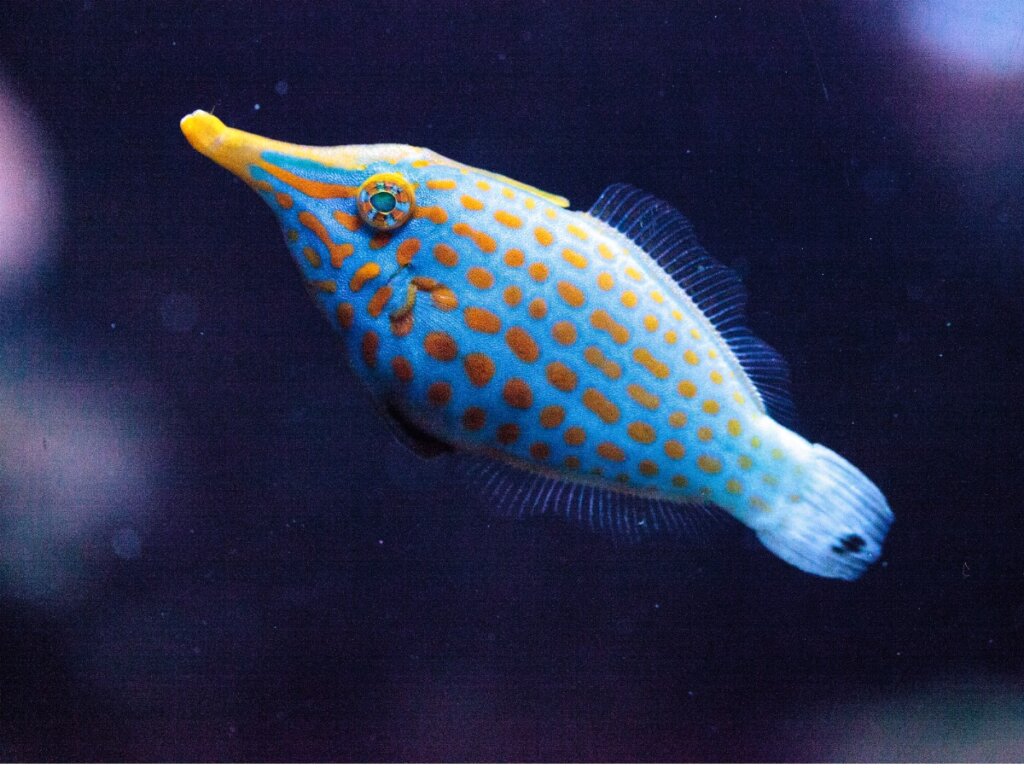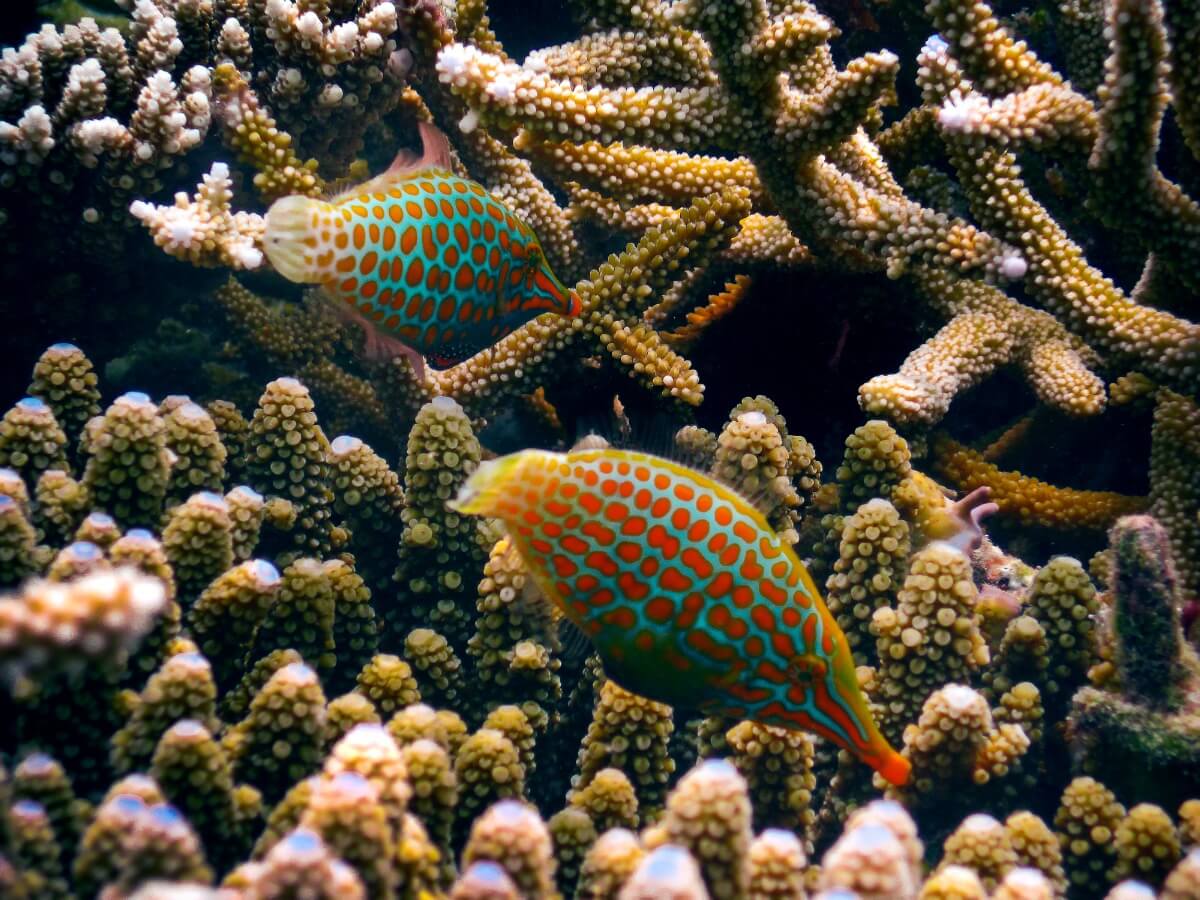Orange Spotted Filefish: Habitat and Characteristics

The orange spotted filefish, also called the harlequin filefish, is a brightly colored marine species whose main feature is the shape of its mouth. In addition, it’s quite small, as it barely reaches 9 centimeters (less than 4 inches) in length, and its fins are also quite small.
The scientific name of this species is Oxymonacanthus longirostris, a beautifully shaped fish that has fascinated several lovers of the marine aquarium in recent years. Read on to learn more about this beautiful species.
Orange spotted filefish habitat
This fish is a common inhabitant of shallow marine waters and has been associated with coral reef areas within the Pacific and Indian Oceans. In addition, it’s usually seen regularly on several islands such as Ryukyu, New Caledonia and Tonga. In fact, it could be said that they’re very selective fish when choosing their home, as they look for the presence of hard corals of the Acropora genus.

What is the orange spotted filefish like?
The body of this fish is oval and it has a long snout whose appearance is the reason for the “filefish” nickname. This particular shape is due to an adaptation that helps it feed on its favorite prey, a long mouth being essential for this. Its fins aren’t so obvious, as they’re quite reduced and end up giving it the appearance of a spear or arrow.
The coloration of its skin is very beautiful, as it has a blue-green background that’s covered with yellow-orange dots and bars. In some cases, the nose and part of its back are pigmented in the same tone as its spots, as if the margin of the fish were being highlighted. Likewise, its eyes are surrounded by yellow tones, which give it a ringed shape and stand out on its body.
How does the orange spotted filefish behave?
In general, it’s a fairly docile and scary fish, as it tends to stay hidden from its predators. However, during their mating, they do show aggressive behavior. What’s more, only in these times do they become territorial animals, so each couple protects their privacy. In the end, they return to their social behavior, sharing space with their peers.
In addition, they’re fish that like to swim in pairs, as they help each other, defending the resources of their territory. Food is an essential aspect for these animals, since reproduction has a high cost for their bodies and they need to compensate for it through an abundant diet.
Feeding
This fish is a corallivorous organism, which means that its diet is based exclusively on coral polyps. For this reason, its habitat is restricted only to the aforementioned reefs, whose conditions encouraged the lengthening of its mouth. This adaptation allows you to take the coral as if it were “tweezers”, avoiding damaging your face and facilitating its survival.
In fact, according to an article published in the scientific journal Coral reefs, snout marlin fish have the ability to distinguish and select the type of coral. They do this by observing the shape and structure of each one and selecting only those of the genus Acropora. This choice isn’t random, because apart from being their food, the branched shape of this coral also serves as a refuge.
This is the reason why it’s considered a difficult species to breed, as it requires the presence of corals inside the tank or aquarium. To give a bit of context, corals and most cnidarians are organisms that are sensitive to changes in water quality. This implies that any slight oversight could cost the lives of all the specimens in the tank.
Reproduction
The orange spotted filefish is a monogamous species that keeps its mate even when it’s not in mating season. Seen in another way, these animals are the best representation of the phrase “until death do us part”, as they’ll only change partners if one of them dies. This situation is what encourages their aggressiveness, as to defend their partner they attack any intruder in their territory.
After courtship, which consists of ramming each other, the female begins to spawn, laying her eggs on the surface of the algae. At this time, the couple starts a game of chase, in which the male follows the female and ends the mating by fertilizing all the eggs with his sperm. These organisms do not present any parental care, so the young will be alone from birth.
State of conservation
The International Union for Conservation of Nature has classified this fish as a vulnerable species. This is due to the great risk that its habitat faces, as it depends on corals to survive. Therefore, situations such as coral bleaching put its population at risk.
30% of Acropora corals are listed in some risk category.
This species is a perfect example of the susceptibility suffered by some specialist organisms. In other words, a domino effect is caused: when one link disappears, the others can’t be sustained, condemning themselves to extinction. Remember that every living being has an important role in nature and, if one disappears, it’ll affect us all whether we like it or not.
All cited sources were thoroughly reviewed by our team to ensure their quality, reliability, currency, and validity. The bibliography of this article was considered reliable and of academic or scientific accuracy.
- Brooker, R. M. R. (2014). Determinants of resource specialisation and its ecological consequences for the corallivorous filefish, Oxymonacanthus longirostris (Doctoral dissertation, James Cook University).
- Barlow, G. W. (1987). Spawning, eggs and larvae of the longnose filefish Oxymonacanthus longirostris, a monogamous coralivore. Environmental Biology of Fishes, 20(3), 183-194.
- Brooker, R. M., Jones, G. P., & Munday, P. L. (2013). Prey selectivity affects reproductive success of a corallivorous reef fish. Oecologia, 172(2), 409-416.
- Kokita, T., & Nakazono, A. (1999). Pair territoriality in the longnose filefish, Oxymonacanthus longirostris. Ichthyological Research, 46(3), 297-302.
- Kokita, T., & Nakazono, A. (1998). Plasticity in the mating system of the longnose filefish, Oxymonacanthus longirostris, in relation to mate availability. Journal of Ethology, 16(2), 81-89.
- Kokita, T., & Nakazono, A. (2000). Seasonal variation in the diel spawning time of the coral reef fish Oxymonacanthus longirostris (Monacanthidae): parental control of progeny development. Marine Ecology Progress Series, 199, 263-270.
